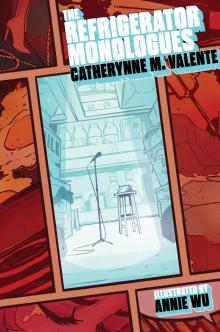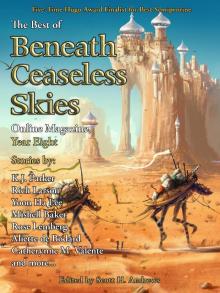


The Atlas of Middle-earth
Karen Wynn Fonstad
To reach Weathertop Strider led the Hobbits along a path that once had served the fortresses along the Hills. The path hugged the west slopes, continuing along the connecting ridge until it climbed a bridgelike bank to the north edge of Weathertop.4 From there the path wound up to the summit, reaching the top in a last steep climb. In the midst of the blackened ring stood a cairn, which held Gandalf’s message stone. Looking down the East Road, Frodo spotted the Black Riders, and the travellers hurried downhill to the dell where they planned to camp.5
On the northwest slope of the hill tucked against the ridge which ran to the Weather Hills was a hollow, and within that was a bowl-like dell.6 Sam and Pippin had explored the area and found a spring nearby in the slope of the hill, and a fall of rocks concealing a stack of firewood.7 Near the spring Strider found bootprints and feared to stay the night; yet they had no alternative. They built their fire in the most sheltered corner of the dell and waited.8 Their fears were well-founded, for over the western lip appeared five black shapes.9
RIVENDELL Inset: THE LAST HOMELY HOUSE
Rivendell
AFTER THE FALL OF OST-IN-EDHIL in S.A. 1697, Elrond led the Elves of Eregion north and founded the refuge of Imladris—Rivendell.1 The settlement subsequently headquartered many of those in the Last Alliance, assisted in the battles against Angmar, and housed Isildur’s heirs through many generations.2 There Aragorn met Arwen, Thorin and Company rested, Bilbo retired, and Frodo was brought for recovery from his knife-wound.3
The deep valley was one of many cutting through the moors sloping up to the Misty Mountains.4 Its sides were so steep that Gandalf’s horse almost slid over the edge when he led the Dwarves east, and the company “slithered and slipped . . . down the steep zig-zag path.”5 There was apparently at least one other path on the south slope, for when the Dwarves met Elves in a glade, the hosts led them to a “good path,” possibly the one in Tolkien’s illustration, shown descending from a long flight of stairs.6 The path led across a narrow bridge that crossed the River Bruinen above the falls, and went on to the house of Elrond.7
The Last Homely House was “’a big house . . . [always] a bit more to discover.’”8 There were at least two large halls: Elrond’s Hall, where the feast was held, and the pillared Hall of Fire, which was just across the passage.9 These were evidently next to the front door, for Frodo could see the glow of the firelight from the outside before the Fellowship’s departure.10 Only three other features were mentioned in the house: Frodo’s room, which was upstairs;11 Bilbo’s room, which was on the ground floor facing south and had a fireplace and a window and door next to the garden;12 and the east-facing porch, where Frodo rejoined his friends and where the Council of Elrond was held.13 Tolkien’s drawing also showed a front porch and a small central tower, which may have held the bells used to signal for meals and for the Council.14 Outside the house there were gardens on the east and south and a path that led along the terrace to a stone seat where Gandalf, Bilbo, Frodo, and Sam met.15 There may also have been stables, where “Bill” was kept; and a forge, where Anduril was prepared for Aragorn.16
Moria
IN THE DEEPS OF THE FIRST AGE, Durin discovered the caves above Azanulbizar, the Dimrill Dale, and there he founded what was to become the greatest of all the Dwarf kingdoms—Khazad-dûm.1 The Dwarves remained there, carving mines that were “vast and intricate beyond the imagination,”2 until T.A. 1980, when a Balrog was released and the realm was abandoned.3 Thereafter the mines were more often named Moria, the black pit.4
The Mountains of Moria
The mines lay in the bowels of three towering mountains: Caradhras, Redhorn; Celebdil, Silvertine; and Fanuidhol, Cloudyhead.5 The Redhorn was the tallest and most northerly, and it held the lode veins of mithril silver.6 The location of the other two peaks was not given, but Tolkien’s map showed one to the west of Mirrormere and one to the east. The Silvertine has been placed in the west because it held the Endless Stair leading to Durin’s Tower, where Gandalf fought the Battle of the Peak;7 and as all of the tunnels mentioned were west of the Dimrill Dale, that great spiraling passage seemed likely to be there as well.
South of Caradhras was a steep winding path over which one could cross the Misty Mountains: the Redhorn Gate.8 The western road was “twisting and climbing . . . in many places had almost disappeared.”9 At the east end it descended into a deep dale, beside “an endless stair of short falls.”10 Gandalf had reckoned it would take “more than two marches” to reach the top of the pass; but the Fellowship was forced down by snow, and instead moved southwest to the Hollin Gate.11
The West-door
During the early part of the Second Age Noldorian Elves had built their city of Ost-in-Edhil in the land of Eregion west of Khazad-dûm. A road ran between the two cities along the River Sirannon, ending at the West-door of the Dwarrowdelf.12 The gate opened onto a shelf that stood “five fathoms” (thirty feet) above the riverbed, over which the Sirannon had originally tumbled in falls. Beside the Stair Falls were steep steps, but “the main road wound away left and climbed up with several loops,” as clearly showed in Tolkien’s drawing.13
The shallow valley was about three eighths of a mile between the falls and the gate, and possibly two miles from end to end.14 The road had originally crossed the shelf between hedges,15 but the Fellowship found the valley had been dammed and was flooded, leaving only a narrow rim around the edge. They skirted the water, crossing a creek at the north end (possibly the source of the Sirannon), and reached the Doors of Durin.16
The Mines
Gandalf calculated it was at least “forty miles from the West-door to East-gate in a direct line.”17 Past the steps at the entrance there were twists in the tunnel, many passages going off in all directions, and cracks and holes across the floor.18 At last Gandalf arrived at a point where an arch opened into three eastward passages—one ascending, one descending, and one level. The travellers camped beside the archway in a guardroom with a well.19 The guardroom has been shown about 3900 feet deep, but there were hammer sounds heard through the well shaft from a lower level.20 The mines could have been as deep as 12,500 feet and still have been within limits reached in our Primary World.21
The ascending passage climbed in great mounting curves with no intersecting tunnels until it came at last to a lofty pillared hall with entrances on each side: the Twenty-first Hall of the North-end.22 They camped in a corner, far from the west door,23 and the next morning they went through the north door toward light, and found the sunshine came from a small chamber on the right of the corridor—the Chamber of Records, which held Balin’s tomb.24 There they were attacked, but they fled through the east door down a steep stair (which apparently ran due east, for Gandalf was thrown backward down the steps).25 To reach the Great Gates Gandalf had said to look for “’paths leading right and downwards,’” yet he made no turns for the passage they were following “seemed to be going in the direction that he desired.”26
After having descended many flights of steps and having gone a mile or more, they reached the Second Hall in the First Deep; but the passage must have veered south during that distance, for they entered the hall on the north with the Gates “away beyond the eastern end, on the left.”27 The hall was much larger than the other they had seen. The Fellowship was on the east end, between a chasm in which fire burned and the abyss spanned by Durin’s Bridge.28 After Gandalf and the Balrog fell into the pit, the others fled “’not more than a quarter mile . . . up a broad stair, along a wide road, through the First Hall, and out!’”29
Upper: MORIA Oblique Cross Section: WEST-EAST Lower Left: WEST END Lower Right: EAST END
Lothlórien
CARAS GALADON WAS “the city of trees.”1 The name was Silvan, adapted to Sindarin, and most of its inhabitants were of Silvan origin;2 although they were governed by Celeborn, a Sindar, and Galadriel, noblest of the Noldor still in Middle-earth.3 Lórien was settled by the Silvan Elves in the First Age, when it was called Lórinand, but there we
re differing versions of when they were joined by Celeborn and Galadriel.4 Galadriel reportedly planted the mallorns, and under the power of her ring the forest realm became Laurelindórinan, Land of the Valley of the Singing Gold; but through the wearing of centuries it faded and so became Lothlórien, the Dreamflower.5
Nimrodel and Cerin Amroth
The travellers entered the Golden Wood about a mile north of Nimrodel—the stream named for the Elfmaiden who once had lived beside the falls.6 After fording the water they decided to sleep in the trees, and by chance they chose the one used by the northern guards.7 The Hobbits stayed the night on the guards’ flet, while the rest of the company slept in a second flet nearby.8 The next day they were guided a short way down the Silverlode and crossed that river on ropes.9
Most of the land of Lórien lay east of the Silverlode in the area known as the Naith or Gore (a triangle of land). Deep in the woods they came to a great mound, crowned with a double ring of trees: The outer were white; the inner gold. In the center stood a towering mallorn, in which was built a flet, once the site of the house of Amroth, the beloved of Nimrodel. The mound was Cerin Amroth, and it was “the heart of the ancient realm as it was long ago.”10 There Arwen and Aragorn had plighted their troth, and after his death it was there she died and was buried.11
Caras Galadon
At length the travellers came to Egladil at the heart of Lórien,12 site of the only city of the realm: a protected city as were all of Tolkien’s major settlements, but with variations unique to the Tree-people. The city was on a hill, surrounded by a wall, but the wall was green, so it may have been earthen rather than built of stone. Outside the wall was a fosse, a ditch or moat, which apparently did not contain water, for it was “lost in soft shadow.” A stone path ran in a semicircle from the northern path to a bridge on the south; and where the Great Gates stood, the walls overlapped forming a “deep lane” within.13
The most unusual feature of the city was, of course, that there were no buildings and towers; but instead the Elves lived on flets (or talans) and houses built within the majestic mallorn trees that covered the hill. As the company climbed the winding path to the summit, although they saw no one, they could hear singing and see lights in the trees above.
On the top of the hill was the largest of all the mallorn trees, which held the house of Celeborn and Galadriel. The dwelling was “so large that almost it could have served for a hall of Men upon the earth.”14 The tree has been illustrated as about four hundred feet in height and breadth, which is slightly larger than the tallest redwood,15 but Tolkien certainly meant the trees to be viewed as immense, saying, “Their height could not be guessed, but they stood up in the twilight like living towers.”16 Up the wide trunk was a ladder, which passed by flets “some on one side, some on another, and some set about the bole of the tree,” until it came at last to the house that held the oval chamber of Celeborn.17
Below the great mallorn was a green lawn on which the Elves set a pavilion for the travellers. Nearby stood a shimmering fountain that fell into a basin, then hurried down the hill.18 Far down the south slope the stream flowed through a treeless hollow: Galadriel’s garden. One could cross through a hedge and descend a long flight of stairs to the lowest point of the dell, where the water ran near another basin and thus provided water for the Mirror of Galadriel.19
After visiting the garden with Galadriel, the company stayed one more day, then departed, going southeast from the gate to the confluence of the Anduin and the Silverlode. The path passed through a wall to a grassy lawn, and slightly upstream was a hythe (a small harbor)20 where their boats were moored.21
Upper: CARAS GALADON Cross Section: NORTH-SOUTH Lower Left: NIMRODEL Lower Center: CERIN AMROTH Lower Right: THE CONFLUENCE
Helm’s Deep
IN THE FIRST DAYS after Gondor was established the Dúnedain fortified the valley leading from Aglarond, the Glittering Caves.1 When the land was ceded to the Éothéod, they took over its fortresses as well; and in T.A. 2758 when Rohan was overrun by Easterlings and Dunlendings, Helm Hammerhand retreated to that refuge, and many of his people stayed there through the siege and the Long Winter that followed. Helm’s desperate deeds during that time made him one of the most famous of Rohan’s kings, and the refuge was named in his honor: Helm’s Deep.2
The Deep
The entire refuge was often called Helm’s Deep, but in the strictest sense the title referred only to the narrow gorge cut by the Deeping Stream between the mouth of the Aglarond and the Hornrock. The presence of caves coupled with a very defensible valley made the Deep ideal for fortification. The caverns were “vast and beautiful . . . [with] chamber after chamber . . . and still the winding paths lead on into the mountains’ heart.”3 Water from the pools eventually must have found its way out into the Deeping Stream, which near the cave’s mouth cut The Narrows where the Ores were trapped the first time they crept through the culvert into the Deep.4
Away from the caves the ravine was somewhat wider, and after the stream wound around the foot of the Hornrock the valley became much more broad. The point where the stream passed from the Deep was called Helm’s Gate,5 and was blocked by the Hornburg and the Deeping Wall—both clearly shown in a drawing by Tolkien.6 The Wall, which has been shown as two hundred fifty feet long, would have been well-manned with Théoden’s two thousand troops, who fought upon the Wall and in the Hornburg.7 They were too few, however, to man Helm’s Dike, which lay only a quarter mile below the Burg, yet stretched a mile or more across the swiftly widening Deeping Coomb. Although the Dike has been described as “an ancient trench and rampart,” it was actually envisioned as a cliff, twenty feet high in places, curving from face to face of the steep mountain wall. The Deeping Stream fell into the coomb below, and the road ran in a cutting beside the stream.8
Between the Dike and the Deep lay a greensward, site of the burial mounds of the Eastfold and Westfold riders who fell in the ensuing battle.9 Although Helm’s Deep was described as winding from the north, it apparently ran somewhat eastward, for two of Tolkien’s maps showed the vale running from the northeast, and the Hornrock was part of the northern cliff.10 The “evermounting hills” which edged the Deeping Coomb “were too steep to climb on the east, but were long, low slopes on the west.11 Saruman’s troops were trapped between the steep hills on the east, Gandalf from the west, Théoden from the Dike, and the Huorns farther down the valley. Thus, they fell, and the heaps of carrion were later laid in one mass grave delved by the Huorns a mile below the Dike: the Death Down. The Dunlendings were buried more honorably, in a separate mound below the Dike.12
The Hornburg
Although the destruction of Saruman’s forces came in the Coomb, the primary struggle had occurred during the night at the major battlement: the Hornburg and the Deeping Wall. The Wall stretched from the outer wall of the Hornburg, over the stream, then on across the gorge. It stood twenty feet high, was wide enough for four men abreast, leaned out like a “sea-delved cliff,” and was topped by a parapet. It had a wide culvert across the stream, its own tower, three flights of steps leading down to the Deep, and another going up to the outer court of the Hornburg.13
The Hornburg was constructed atop the Hornrock, a “heel of rock thrust outward by the northern cliff.”14 The Rock was no more than forty feet high, and required only a ramp, rather than a winding road to reach from the causeway across the stream to the Great Gates.15 The Hornburg consisted of two stout walls surrounding the outer court, the inner court, and the central tower (which was sometimes called “the Burg").16 These walls have been shown as slightly thicker and higher than the Deeping Wall, for they were considered to be more difficult to attack.17 The tower, though “lofty,” was much lower than that of Minas Tirith.18 The outer wall of the Hornburg had three entrances: the Great Gates; the Postern Door next to the cliff, through which Aragorn and Éomer passed to defend the main gates;19 and the Rear-gate, through which Aragorn and Legolas escaped the Ores in the Deep.20 The stairway from
the Deeping Wall probably also could be closed off. The Great Gates were topped by a stone arch that apparently had a walkway at the rear, for Aragorn stood above the gates watching the sunrise. A moment later the gates were blasted open, and Aragorn joined Théoden’s guard (who were mounting their horses in the inner court where they were stabled), then charged through the rubble to do battle.21
Upper: HELM’S DEEP Center: THE HORNBURG Lower: CROSS SECTION
Isengard
LIKE THE FORTIFICATIONS of Helm’s Deep, the works at Isengard were made by the Dúnedain in the early days of Gondor;1 but unlike Helm’s Deep, Isengard was not given to the Éothéod when Rohan was ceded. It was kept by Gondor, but at some point became deserted. After T.A. 2758, when Rohan was overrun and Isengard seized by Dunlendings, Saruman was given the keys to Orthanc,2 and the great valley surrounding Isengard was named Nan Curunír, the Valley of Saruman—the Wizard’s Vale.3














